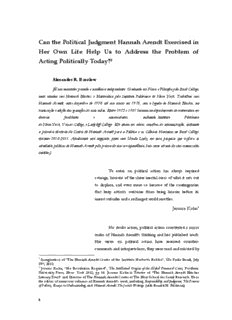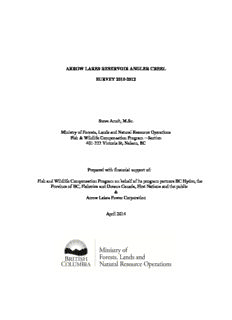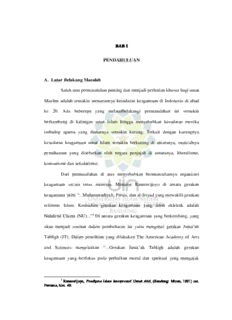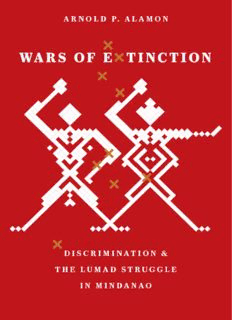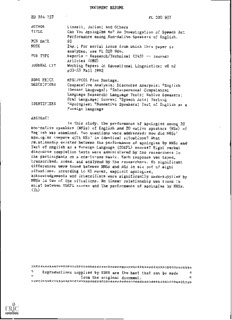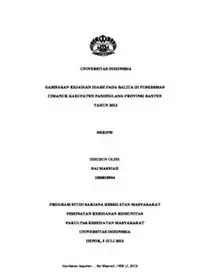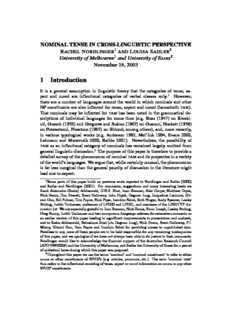
NOMINAL TENSE IN CROSS-LINGUISTIC PERSPECTIVE PDF
Preview NOMINAL TENSE IN CROSS-LINGUISTIC PERSPECTIVE
NOMINAL TENSE IN CROSS-LINGUISTIC PERSPECTIVE RACHEL NORDLINGER1 AND LOUISA SADLER2 University of Melbourne1 and University of Essex2 November 18, 2003 1 Introduction It is a general assumption in linguistic theory that the categories of tense, as- pect and mood are inflectional categories of verbal classes only.1 However, there are a number of languages around the world in which nominals and other NP constituents are also inflected for tense, aspect and mood (henceforth TAM). That nominals may be inflected for TAM has been noted in the grammatical de- scriptions of individual languages for some time (e.g. Boas (1947) on Kwaki- utl, Guasch (1956) and Gregores and Sua´rez (1967) on Guaran´ı, Hockett (1958) on Potawatomi, Firestone (1965) on Siriono´, among others), and, more recently, in various typological works (e.g. Anderson 1985, Mel’cˇuk 1994, Evans 2000, Lehmann and Moravcsik 2000, Raible 2001). Nevertheless, the possibility of TAM as an inflectional category of nominals has remained largely omitted from general linguistic discussion.2 The purpose of this paper is therefore to provide a detailedsurveyofthephenomenonofnominal TAM anditspropertiesinavariety oftheworld’slanguages. Wearguethat,whilecertainlyunusual,thephenomenon is far less marginal than the general paucity of discussion in the literature might leadonetoexpect. 1Some parts of this paper build on previous work reported in Nordlinger and Sadler (2000) and Sadler and Nordlinger (2001). For comments, suggestions and many interesting leads we thank Alexandra (Sasha) Aikhenvald, D.N.S. Bhat, Joan Bresnan, Alec Coupe, Matthew Dryer, Nick Evans, Dan Everett, Brent Galloway, John Hajek, Dagmar Jung, Jacqueline Lecarme, Hit- omiOno,BillPalmer,TomPayne,NickPiper,JoachimSabel,RuthSinger,AndySpencer,Lesley Stirling,JudithTonhauser,audiencesofLFG00andLFG01,andmembersoftheLINGTYPdis- cussionlist.WeareespeciallygratefultoJoanBresnan,NickEvans,BrianJoseph,LesleyStirling, GregStump,JudithTonhauserandtwoanonymousLanguagerefereesforextensivecommentson anearlierversionofthispaperleadingtosignificantimprovementsinpresentationandanalysis; andtoSashaAikhenvald, SebastianaErtel(viaDagmarJung), NickEvans, BrentGalloway, P.J. Mistry, Hitomi Ono, Tom Payne and Joachim Sabel for providing access to unpublished data. Needless to say, none of these people are to be held responsible for any remaining inadequacies ofthispaper, andweapologiseifwehavenotalwaysbeenabletodojusticetotheircomments. Nordlinger would like to acknowledge the financial support of the Australian Research Council (APDF9930026)andtheUniversityofMelbourne,andSadlertheUniversityofEssexforaperiod ofsabbaticalleaveduringwhichthispaperwasprepared. 2Throughoutthispaperweusetheterms‘nominal’and‘nominalconstituent’torefertoeither nouns or other constituents of NP/DPs (e.g. articles, pronouns, etc.). The term ‘nominal TAM’ thusreferstotheinflectionalencodingoftense,aspectormoodinformationonnounsoranyother NP/DPconstituents. 2 The existence of tense/aspect/mood as an inflectional category for nominals has significant implications for many aspects of linguistic theory. It challenges theories of word class categorization which see nouns as inherently time-stable, andthereforenotopentotemporalmodification,unlikeverbs(Givo´n1979,2001); as well as those that consider distinct inflectional categories to be central to the establishment of distinct word classes of nouns and verbs. TAM-inflected nomi- nalsalsohaveinterestingimplicationsforsemantictheoriesthatconsidernounsto besemanticpredicateswiththeirowntemporalinterpretationindependentofthat of verbs (e.g. Enc¸ (1981, 1986), Musan (1995), among others); and for formal grammatical architectures that assume that clausal tense information must nec- essarily be associated with the clausal head (usually the verb). These and other implicationsarediscussedinfurtherdetailinsection4. The primary purpose of this paper is to establish the existence of the phe- nomenonofnominal TAM,bydemonstratingtheformalandfunctionalproperties of TAM marking on nominals in a variety of languages of the world. With this in mind, we have largely restricted our discussion here to what we take to be the mostcentralor‘core’instancesofthisphenomenon,namelythosecasesinwhich (constituentsof)dependentNPsareinflectedfor(standardlydefined)categoriesof tense,aspectand/ormood. TheseconstitutethecorecasesofTAM-inflectednomi- nalssincetheywouldseemtoprecludetraditionalanalysesthattreattense,aspect and mood as only inflectional properties of verbs, verbal auxiliaries or functional heads such as particles.3 If the encoded TAM category is a part of the inflectional system of the nominal, then it clearly belongs to the NP/DP in the syntax. Fur- thermore, if the NP/DP in question is a dependent of the clause (i.e. functioning asanargumentoradjunctofaclauseheadedbyaverb),thenthepresenceof TAM markingcannotbeattributedtoitbeingaclausalpredicateorhead. There are many other ways in which tense, aspect and mood can come to beassociated withnominals whichcould quiteproperly beincluded inacompre- hensive typology of nominal TAM, but are not discussed here in any great detail. These include the cross-linguistically common situation in which clausal TAM is encodedonnominalpredicatesinverblessclauses. Thistypeof TAM onnominals is simply the nominal equivalent of regular verbal tense on verbal predicates, and isthereforelesschallengingforstandardconceptionsof TAM,andlessinteresting for our present purposes. However, it is clearly an example of the encoding of 3Opinionsdifferastowhethertense,aspectandmoodshouldbeconsideredpropertiesofthe clauseitself,oroftheclausalhead(i.e.theverb). FoleyandVanValin(1984:224)andVanValin andLaPolla(1997:47)treatallthreedifferently: forthem,aspectisapropertyofheads(‘nuclear layer’), tense a property of the clause, and (root) modality a property of the ‘core’ (including the head and its core arguments). It is important, however, to distinguish between the seman- tic/syntacticscopeofacategory,anditsmorphologicalrealisation. Tense,aspectandmood,when encoded morphologically in a language, are usually inflectional properties of verbs, despite the factthattheirsyntacticandsemanticscopemaybeclausal(orotherwise). 3 regularTAMonnominalconstituents. ThistypeofnominalTAMmarkingisfound in many Austronesian languages (e.g. Mwotlap (Franc¸ois 2003)) and numerous otherlanguagessuchasAbaza(O’Herin1995),BininjGun-wok(Evansinpress), Tundra Nenets (Salminen 1997), Turkish (Lehmann and Moravcsik 2000:742), Tzutujil(Daley1985,citedinBaker2003:51),aswellasinmanyofthelanguages whichwediscusshere. A second type of TAM marking on nominals that will not be discussed in detail here involves elements which might be considered (clausal) TAM clitics that are phonologically attached to nominal constituents. Examples include the Serbo-Croatian auxiliary, and the clitic auxiliary ’ll in English, as in ‘John’ll be home tomorrow’. Such elements are, by definition, syntactically and morpholog- ically independent, attaching to their hosts at a purely prosodic level. Clitics of this sort (Halpern’s (1995) ‘bound words’) are syntactic rather than inflectional elements, and are therefore excluded from discussion here, though they do raise manyinterestingissuesintheirownright.4 Indeedmanylanguagesdohavefloat- ing TAM cliticswhichmayattachtoavarietyofconstituentsincludingdependent NPs. Languages in which such clitics attach to dependent nominals to encode the TAM for the clause include the Australian language Garrwa (Furby and Furby 1977),andtheArawaklanguagesApurina˜ (Facundes2000)andTariana(Aikhen- vald2003,seealsosection2.1). Further, we do not consider as examples of nominal TAM such vestiges of verbaltense/aspect/moodmarkingasmayberetainedindeverbalnominalisations. In Polish, for example, the imperfective/perfective aspectual distinction encoded with verbs is retained in derived action nominals. Thus, corresponding to the verbal pair czytac´ (imperfective)/przeczytac´ (perfective) ‘to read’ are the derived action nominals czytanie/przeczytanie. While both could be translated into En- glish as ‘the reading’ (e.g. ‘The reading of the book gave me much pleasure’), czytanie refers to the process of reading, while przeczytanie refers to the totality oftheactofreading(ComrieandThompson1985:363). Thisaspectualdistinction is clearly an inflectional category of the original verb, rather than of the nominal wordclasstowhichthederivedformsbelong. The languages discussed in this paper together provide a good illustration of what we take to be core cases of nominal TAM and share (at least) the following characteristics:5 4Of course itmay well be thatsome cases of TAM clitics turnout on closer analysisactually to be morphological rather then syntactic elements, such as Halpern’s (1995) ‘unusually placed inflectional affixes’, which he terms ‘lexical clitics’. These may therefore be properly treated as inflectional elements in some (extended) model of inflection (see for example Anderson’s treat- mentofcliticsasphrasalaffixes(Anderson1993)). Inthiscase, suchelementswouldconstitute furthercoreexamplesofthephenomenonweaddressinthispaper,butweerronthesideofcaution hereinomittingthemfromthepresentdiscussion. 5In the interests of space, we illustrate aspects of the phenomenon with a small number of languages,butendeachmajorsectionwithalistingofallthelanguageswhichwehavefoundto 4 (i) nouns(orotherNP/DPconstituents)showadistinctioninoneormoreofthe categoriesoftense,aspectandmood,wherethesecategoriesarestandardly definedastheywouldbeforverbs(e.g.Crystal1997); (ii) this TAM distinctionisproductiveacrossthewholewordclass,andnotsim- plyrestrictedtoasmallsubsetofforms;6 (iii) the TAM distinction is not restricted to nominals functioning as predicates of verbless clauses, but is encoded on arguments and/or adjunct NP/DPs in clausesheadedbyverbs; (iv) the TAM markerisamorphologicalcategoryofthenominalwordclass,and cannot be treated as a syntactic clitic that merely attaches to the NP/DP phonologically. The encoding of TAM on nominals can have one of two broad functions. In one it specifies information intrinsic to the nominal itself, independently of the TAM of the clause. We refer to this type as ‘independent nominal TAM’ (section 2.1).7 Alternatively, it may function to provide TAM information for the whole proposition, often (but not always) in conjunction with the TAM of the verb. We term this type ‘propositional nominal TAM’ (section 3). In the remainder of this paper we discuss the formal and functional properties of these two types in some detail, exemplifying from a range of typologically and genetically diverse lan- guages. In section 4 we discuss the implications of this nominal TAM data for linguistictheoryingeneral. 2 Independent nominal TAM 2.1 Independent nominal tense Since nominal (semantic) predicates as well as verbal predicates may be tempo- rally located (e.g. ‘ex-soldier’, ‘former friend’, ‘future President’, ‘wife-to-be’), date with the relevant type of nominal TAM marking. Since the aim of this paper is not to carry outatypologicalsurveybasedonanarealorgeneticsamplingmethodology,thelistoflanguages we survey here is certainly not exhaustive. Neither is it fully representative in the geographical, genetic and typological distribution it reflects. Nonetheless, we aim to show here something of the formal and functional properties of TAM marking on nominals and thereby stimulate further research in the area of TAM-inflected nominals, and the use of TAM with other non-verbal con- stituentsmoregenerally. 6Thusweexcludeformslike‘ex-’inEnglish,whichapplyonlytoasmallsemanticallydefined classofnominals: ‘ex-wife’,‘ex-boss’,butnot? ‘ex-dog’,? ‘ex-desk’. Seesection2.1forfurther discussion. 7In precursors of this work this type of nominal TAM-marking was referred to as ‘non- propositionalnominalTAM’. 5 thereisnoreasoninprinciplewhynominalscouldnotbearTAMinflectionoftheir own. Indeed,contrarytowidely-heldassumptions,suchnominal TAM markingis attestedacrossarangeoflanguages,includingmanyfromNorthandSouthAmer- ica. Nominal TAM inflection in this function operates completely independently of the TAM of the clause, and serves to locate the time at which the property de- notedbythenominalholdsofthereferentor,inthecaseofpossessivephrases,the time at which the possessive relation holds. Thus, it provides temporal informa- tion local to the NP to which the nominal belongs. In this sense, it is functionally analogous to regular verbal tense which provides information local to the phrase headedbytheverb(namely,theclause). A straightforward example of independent nominal TAM inflection is pro- videdbyTariana,anArawaklanguagefromnorth-westAmazonia,Brazil.8 Nouns inTarianacanbeinflectedforeitherpastorfuturetense(unmarkednounsareun- specified for tense) (Aikhenvald 2003).9 The occurrence of tense morphology on nominalsisverywidespread,indeedAikhenvaldreportsthataround40%ofnouns intextsaretense-inflected. There is a single form for nominal future tense, -pena, which specifies that the property denoted by the nominal holds in the future: wa-(cid:217)imaRi-pena (1PL- son.in.law-FUT) ‘our future son-in-law’; pi-ya-dapana-pena (2SG-POSS-house- FUT) ‘your future house’. Nominal past tense has three forms: miki-Ri for mas- culine singular nouns, -miki-Ru for feminine singular nouns, and -miki for plural nouns. Itisusedmorewithanimatesthaninanimates,butpossiblewithboth. Ex- amples include correio-miki-Ri (post office-PST-NF) ‘old/former post office’ and du-sa-do-miki-Ru (3SG.NF-spouse-FEM-PST-FEM) ‘his late spouse’ (Aikhenvald 2003). In contrast, propositional tense is encoded via floating tense/evidentiality cl- itics, which attach phonologically to the verb or any other focused constituent (including nominals). The nominal tense system is much simpler than that of the propositionaltense/evidentialityclitics,andtheformsarequitedistinctfromtheir propositionalcounterparts(seeAikhenvald(2003)fordiscussion). Examplesoftheuseofthesenominaltensemarkersinregularverbalclauses are given below. The fact that the temporal reference of the nominal can be inde- pendent of that of both the verb and the clause within which it appears, is illus- trated by (2) in which a future tense nominal co-occurs with a verb carrying the reportedremotepastclitic:10 8ThedataprovidediscourtesyofSashaAikhenvald,andistakenfromhergrammar(Aikhen- vald(2003)). Atthetimeof writingthe publishedgrammarwasnot yetavailable andsoweare unabletoprovidepagenumbersfortheexamplesthatwecite. 9Although Aikhenvald describes these nominal tense markers as clitics they appear inside oblique case markers, which she considers to be suffixes (Aikhenvald 1999) and so for our pur- posesareclearlypartoftheinflectionalmorphologyofnouns. 10Non-obvious abbreviations in these examples include: AFF ‘affix’, CL.ANIM ‘animate 6 (1) Thepi di-maRe=pidana eta-miki-Ri-nuku. to.water3SG.NF-throw.CAUS=REM.P.REP eagle-PST-NF-TOP.NON.A/S ‘Hethrewtheremainsoftheeagle(lit. the‘ex-eagle’,whatusedtobethe eagle)intowater.’ (2) Kayu-makah˜ı waRipeRe unyane-penadi-kakwa=pidana. so-AFF DEM:ANIM Walipereflood-FUT 3sg.NF-plan=REM.P.REP ‘ThusWaliperewasplanningthefutureflood.’ Such data raises the question of how (or even whether) this type of nominal tense marking is to be distinguished from derivational affixes such as the English ‘ex-’ (e.g. ‘ex-husband’, ‘ex-President’). The distinction is not at all straightfor- ward – the two types of affixes clearly cover some of the same semantic ground – but it is possible to identify some significant differences.11 Most importantly, nominal tense markers are fully productive, inflectional affixes that attach to all (regular) members of the nominal word class. The prefix ‘ex-’ in English, on the other hand, is quite restricted in its semantics and more clearly derivational in function. It is most common with nouns denoting occupations (‘ex-President’, ‘ex-director’, ‘ex-teacher’) and non-kin relationships (‘ex-wife’, ‘ex-boyfriend’). It is substantially less appropriate with common nouns such as ‘dog’ and ‘house’ (?ex-dog, ?ex-house). Such restrictions are not found in the true nominal tense examples, as can be verified in the examples throughout this section. Further evidence for the inflectional status of nominal tense affixes can be found on a language specific basis. In some languages nominal tense forms portmanteaux with other inflectional nominal categories, such as possession and definiteness (see the discussions of Hixkaryana and Somali below, respectively). In some lan- guages independent nominal tense is encoded with the same affixes that are used to encode regular verbal tense with verbs (see the discussion of Potawatomi and Halkomelem Salish below, for example). And in other languages independent nominaltensecanbeshowntobesyntacticallyactive,triggeringadjectivalagree- ment(seeSomali). A similar nominal tense constrast to Tariana is found in Guaran´ı, a Tup´ı- Guaran´ı language which is widely spoken in Paraguay (Guasch 1956, Gregores and Sua´rez 1967, de Canese 1983, see also the brief discussion in Mel’cˇuk 1994:54). Guaran´ı has the nominal tense suffixes -kwe´ PST (sometimes -re´), ra(cid:9)(cid:1)12 FUTand-rangueforafuturewhichisnottoberealized(thatis,anirrealisfuture), whichoccuronnominalargumentsandonnominalisations. Examplesinclude: classifier’, DEM.ANIM ‘demonstrative animate’, NF ‘non-feminine’, PAUS ‘pausal’, PRES.VIS ‘presentvisible’,REL‘relative’,REM.P.REP‘remotepastreported’,TOP.ADV‘topicadvancement’, TOP.NON.A/S‘topicalnon-subjectclitic’. 11WearegratefultoMatthewDryerfordiscussionofsomeoftheseissues. 12Forthetypesetters: (cid:1)(cid:9)ahereandinexample(4)shouldbea˜ with´superimposed. 7 (3) h-o´ga-kwe´ his-house-PST ‘hisformerhouse’(GregoresandSua´rez1967:127) (4) h-emi-apo`-ra(cid:9)(cid:1) his-work-FUT ‘hisfuturework’(ibid) (5) ao`-apo`-ha`-re´ makerofclothes-PST ‘theonewhomadetheclothes’(ibid) In possessive examples such as (3) and (4), there are two semantic predi- cates with respect to which the tense marker may logically be interpreted. One possibility is that the tense marker temporally locates the nominal referent itself (e.g. ‘former house’). Another possibility is that the tense marker refers not to the nominal, but rather provides the time at which the possessive relation holds (e.g. ‘formerly possessed’). These Guaran´ı examples are in fact ambiguous: ex- ample (3) can mean either ‘my thing which used to be a house (e.g. it has burned down)’or‘thehousewhichusedtobemine(butnowbelongstosomebodyelse)’. Suchambiguityappearstoholdinthelargemajorityoflanguageswhichcombine independent nominal TAM marking with possessor inflection (including Tariana exemplifiedabove). The independence of the nominal tense from the TAM of the whole proposi- tioninGuaran´ıisillustratedbythefollowingexamples,inwhichthepropositional andnominaltensevaryindependentlyofeachother.13 (6) O-va-ta che-ro´ga-kue-pe. 3-move-FUT 1SG-house-PST-in ‘Hewillmoveintomyformerhouse.’ (7) A-va-va’ekue ho´ga-ra˜-pe. 1SG-move-PST 3.house-FUT-in ‘Ihavemovedintohisfuturehouse.’ In the above languages, the independent nominal tense system is formally distinctfromthetensemarkingsystemofverbs. However,ifsuchnominalinflec- tion is truly encoding tense categories similar to those more familiarly encoded on verbs, then we might expect to find the same markers encoding tense cate- gories with both nouns and verbs. This has in fact been reported for a number 13ThefollowingGuaran´ıexamples,including(37)below,werekindlycollectedforusbyDag- mar Jung from Sebastiana Ertel, a native speaker of Guaran´ı from Asuncio´n now resident in Cologne, Germany. The examples from Gregores and Sua´rez (1967) ((3) - (5)) are written in whatwasatthetimestandardGuaran´ıorthography,whiletheinformantdataisrepresentedinthe currentstandardorthography. 8 of North American languages including Potawatomi (Hockett 1958), Kwakw’ala (Anderson1985)andHalkomelemSalish(Galloway1993,Burton1997).14 Hock- ettprovidesthefollowingillustrativeexamplesfromPotawatomi(1958:238):15 (8) a. nk@sˇat@s ‘Iamhappy(verb)’ b. nk@sˇats@p@n ‘Iwasformerlyhappy(butnotnow)’ (9) a. ncˇiman ‘mycanoe(noun)’ b. ncˇimanp@n ‘myformercanoe,nowlost,destroyed,orstolen’ Brent Galloway (p.c.) provides examples from Halkomelem Salish showing thatbothnounsandverbscanbetense-inflected(withthesamesetofforms)inthe sameclause. Thetense-inflectionontheverb(orverbalauxiliary)encodespropo- sitional tense, and that on the noun encodes independent nominal tense. Example (10)containsbothpropositionalpasttensemarking(encodedonthenegativeaux- iliary) and independent nominal past tense marking (encoded on the object NP), thus illustrating that the same form can be used in two functions in the same clause. (10) e´we-lh kw’e´tslexwthe-l s´ı:l-a´:-lh. NEG.be-PST see the(f)-mygrandparent-PST ‘Hedidn’tseemylategrandmother.’ (BrentGalloway,p.c.) This is contrasted with the following example, in which the object NP re- mains in the past tense while the verb is encoded for future tense. This clearly demonstrates that the nominal and verbal tense systems are independent of each other(despitetheidentityofform),otherwisewewouldexpectsuchcasesofcon- flictintensevaluestoresultinungrammaticality. (11) El-’e´liyemet-tsel-cha the-l s´ı:l-a´:-lh. REDUP-dream.about-1SG.SUBJ-FUT the(f)-mygrandparent-PST ‘I’llbedreamingaboutmylategrandmother.’ (BrentGalloway,p.c.) 14Outside of North America, the use of a single set of tense markers to encode both regular tenseonverbsandindependenttenseonnominalshasbeenreportedfortheAmazonianlanguage Jarawara(Dixon2004). 15Interestingly, Joseph(1979)discussestheuseofasimilarsuffixinCree(-ipan), whichalso means‘former,past’. However,inCreethemarkerismoresimilartoEnglish‘ex-’,beingpossible onlywithnounsthatdenotelivingentities. Thusnimoso¯m-ipan‘mylategrandfather’ispossible, butnot*nitospwa¯kan-ipan‘myformerpipe’. 9 2.2 Independent nominal tense and possession In the languages discussed above, we’ve seen examples in which the interpreta- tion of the nominal tense inflection is ambiguous between the temporal location of the nominal referent itself, or the temporal location of the possessive relation of which the nominal is the object. In some languages this latter use has been grammaticised such that it is the only interpretation possible for nominal tense inflection. This is the case for many Carib languages, and we illustrate this for Hixkaryana(Derbyshire1979,1999).16 In Hixkaryana independent nominal tense is expressed with a series of port- manteau nominal suffixes which mark present, past and remote past possession, and depossession.17 The possessor is coded by a prefix which expresses person, and which co-occurs with the suffixal possession/tense markers. Here the tense marker serves to temporally locate the possessive relation, rather than the prop- erty denoted by the nominal, so that ro-kanawa-tho ‘1-canoe-POSS.PAST’ means ‘canoewhichusedtobemine’,ratherthan‘mythingwhichusedtobeacanoe’. ThefollowingexamplesareprovidedbyDerbyshire(1979:98-99).18 (12) Ro-kanawa-R1 (13) Ro-kanawa-tho 1-canoe-POSSD 1-canoe-POSSD.PST ‘mycanoe’ ‘thecanoethatusedtobemine’ (14) ow-ot-t1 (owot1) (15) ow-wo-t1-th1R1 2-meat-POSSD 2-meat-POSSD-PST ‘yourmeat’ ‘thatmeatwhichusedtobeyours’ (16) 1-he-tSe (17) 1-he-tSe-nh1r1 3-wife-POSSD 3-wife-POSSD-PST ‘hiswife’ ‘hisformerwife’ 16SimilarfactstotheHixkaryanaonesdiscussedherepertainintheotherCariblanguagesin- cludingApalai(KoehnandKoehn1986),Macushi(Abbott1991),WaiWai,Carib,Dekwana,Trio, andWayana(Derbyshire1999). 17AccordingtoDerbyshire(1999)thedepossessionsuffixappears(althoughrarely)oninalien- ablypossessednounstoindicatemoregeneralreference. 18Intheexamplesinthissection,someminoralterationshavebeenmadeintheglossesinorder to increase glossing consistency across the languages discussed. Non-obvious abbreviations in theseexamplesincludeDEV‘devalued’,REM‘remote’. Notethatthesimplepastsuffixnormally follows all allomorphs of the possessor suffix except r1, which it replaces. When this occurs we glossitasPOSS.PST. 10 (18) Ro-katxho-ø (19) 1-katxho-ø-th1r1 1-things-POSSD 3-things-POSSD-PST ‘mythings’ ‘hisoldthings’ The following examples show nominal and verbal tense marking varying in- dependently–presentpossessiononanominalco-occurswithverbalpasttense.19 (20) ro-kanawa-r1 mar-yako uro ryhe 1ro ha 1-canoe-POSS 2S.3O.take-REC.PST.COMPL mine EMPH that INT rokanawar1. 1-canoe-POSS ‘Youtookmycanoe,thecanoethatbelongstome’(ibid:129,288) (21) Warakay-ow-t1 yakaro1-to-no. Waraka 3-brother-POSS with 1S.3O-go-IMM.PST ‘IwentwithWaraka’sbrother’(ibid:11,22b) 2.3 Independent nominal mood and evidentiality In all of the languages with independent nominal TAM systems that we have dis- cussed above, the only TAM category encoded is the category of tense. In fact, all languages we have found with some independent nominal TAM encode min- imally the distinction between past and non-past tense. In some languages this is the only distinction encoded (e.g. Hixkaryana); others have a future tense also (e.g.Tariana,Guaran´ı). Wehavefoundnolanguagesinwhichindependentaspect is marked on nominals.20 However, there appears to be no principled reason as to why this should be the case, given that such meanings can be encoded by ad- jectives in languages without inflectional nominal TAM systems (e.g. my ongoing journey, my completed journey, my continuing journey), and may simply be an accidentalgapinthedata. Itispossible,however,forlanguagestoencode(some) independent mood information on nominals. Two such languages include Iateˆ, which marks possibility, and Nambiquara which marks evidentiality.21 Crucially, however,theselanguagesalsomarknominalsforindependenttense. Iateˆ (sometimes Yateˆ) is a Macro-Jeˆ language spoken in the vicinity of Per- nambuco (Brazil). According to Lapenda (1968), nouns in Iateˆ can be inflected for one of three tenses (past, present and future) and one of two moods (‘realis’ 19ThesystemofverbaltensemarkinginHixkaryanaisconsiderablycomplex, seeDerbyshire (1979: 136)fordetails. 20Inonelanguage,Jarawara(Dixon2004),asuffixglossed‘habitual,customary’isusedwitha predicatenominalinapparentindependentfunction,see(36)below. Whilethissuffixappearsto haveanaspectualmeaning,itdoesnotformpartofasystematicaspectualcontrastinthelanguage, andsowedonotconsiderittobeaclear-cutexampleofindependentaspectonnominals. 21Jarawaraalsomarksnominalsforindependentmoodandevidentiality,seeDixon(2004).
Description:The list of books you might like

The 48 Laws of Power

The Mountain Is You

The 5 Second Rule: Transform your Life, Work, and Confidence with Everyday Courage

What Happened to You?

Crime Scene Investigation
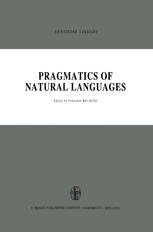
Pragmatics of Natural Languages

Nonlinear Oligopolies: Stability and Bifurcations
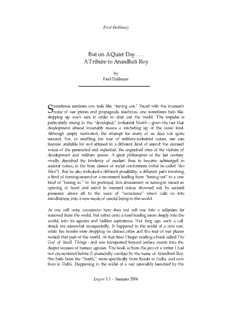
But on A Quiet Day . . . A Tribute to Arundhati Roy
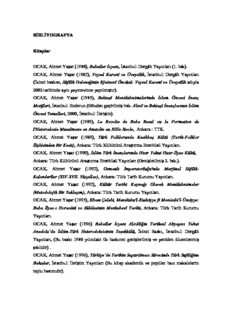
BİBLİYOGRAFYA Kitaplar OCAK, Ahmet Yaşar (1980), Babaîler İsyanı, İstanbul
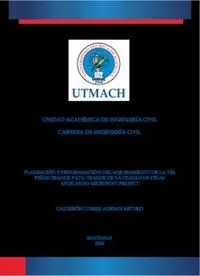
Convert JPG to PDF online

Como lidar com a sogra

bênção de um abade e de uma abadessa

Bê-a-Blog
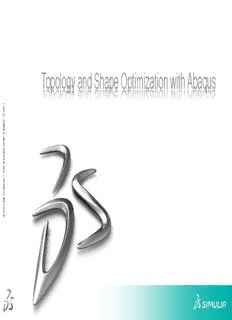
Topology and Shape Optimization with Abaqus

ERIC EJ738089: Meaningful Responses to Literature

cadernos de história
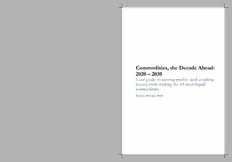
Commodities, the Decade Ahead: 2020 – 2030

Annual report : 2005/2006
